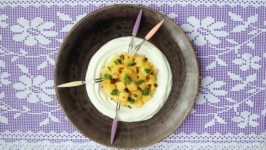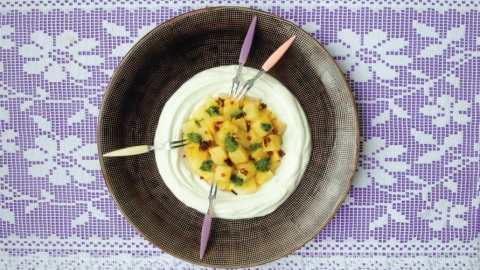Pantry Travels
With bustling alleys and friendly merchants advertising neatly piled aromatic wares, a Middle Eastern spice market is a vivid experience for all the senses. Eyes feast on a vibrance of reds, yellows, greens. Ears listen in on foreign tongues. Nostrils absorb the intoxicating aromas of the craziest abundance of spices, both whole and ground. Spicy particles tickle the throat. And hands, when given that opportunity, explore the touch of unfamiliar ingredients such as rock-hard dried lemons or weirdly thready whole mace.
Variety is the proverbial spice of life. And with a varied pantry you can plot an itinerary to a different country every day. It becomes a treasure chest filled with flavorful souvenirs from world travels—even if you only trekked to the shelves of your local grocery, spice or kitchenware store.
Maybe in that pantry hides a masala dabba, an Indian spice box. It’s like a jewelry box for cooks, containing several small cups brimming with the cook’s favorite spices, each one toasted, ground and ready. In India, a beautiful masala dabba would be an heirloom passed from generation to generation.
Bottled hot sauces in various degrees of heat, color and provenance roost on a shelf. Do you conjure the smell of fermented peppers in the air over Avery Island in Louisiana every time you open a bottle of Tabasco? Or do you share our craving for Lao Gan Mas crispy chili oil spooned on everything, even peanut butter?
Perhaps in the pantry’s darkest corner squats a Korean earthenware jar, bubbling inside with kimchi in the making.
And there’d be jars with pickles, created from recipes you discovered (mind) traveling to far-flung lands. Unlock a jar of Swedish smörgåsgurka (pickled cucumbers) or Indonesian achar campur (vegetables pickled with turmeric, ginger and chili), and it’s like you’re back in another place—even if you never been there.
Here are some treasures to uncover on pantry travels.
YOUR OWN SPICE ROUTE
Five-spice was born some 3,000 years ago in China, apparently as a wonder powder that blended the five tastes in Chinese cuisine: bitter, salty, sour, spicy, sweet. Combining (alphabetically) cinnamon, cloves, fennel seeds, Sichuan peppercorns and star anise, five-spice rubs very well with meats and vegetables galore.
Ras el hanout is an enigmatic spice mix said to originate in Morocco but favored throughout the Maghreb. At the base is cardamom, chili, cinnamon, cumin, ginger, nutmeg, paprika and turmeric, but many other (and less familiar) spices are often added. A complex ras al hanout can combine dozens of spices. The name (meaning “top of the shop” in Arabic) refers to the best spices chosen to unite— and apparently every home cook and chef guards their own “top of the shop” concoction as a secret.
Ethiopian berbere rounds up a fiery bunch of ground dried chilies joined by spices like cardamom, fenugreek, paprika and more. It’s what gives that beautiful doro wat (chicken stew) its pungent kick. In the same way, berbere stirred into your own stew will give it an exciting dimension.
Koekkruiden (Dutch for cookie spices) is a sweet and warm blend similar to pumpkin spice but with a few additional spices such as anise seeds and white pepper. It is used in the Netherlands to make a traditional cookie called speculaas and also peperkoek (a Dutch honey cake).
YOUR ADOBO, MY ADOBO
Adobo in Mexico is different from what you’d find in a Filipino kitchen. Both are worth bringing into your own kitchen, for different cooking adventures. Mexican adobo is essentially a ground chili paste made with dried chilies like ancho and guajillo and used as a seasoning for soups, moles and stews; Filipino adobo is the name of a sweet and tangy dish, often chicken, at the base of which is a marinade (adobar is Spanish for “marinate”) with vinegar and soy sauce, among other ingredients.
SOMETHING FISHY
Fish hung to dry in the wind on an Icelandic coastal cliff are a smelly affair, but it yields a delicacy wanted the world over. Salt fish is a key ingredient in recipes ranging from Jamaican accras (fritters) all the way to Portuguese baked bacalhau.
Katsuobushi (dashi) are ultrathin dried bonito flakes. They are quite intense and a little goes a long way to flavor your dish.
Ikan bilis (dried anchovies loved in Indonesia, Malaysia and Singapore) make a terrific appetizer when soaked, patted dry, quickly fried with sliced shallots and chili pepper and finished with freshly squeezed lime juice.
Dried shrimp are a perfect item to stash, both whole (whirl them into a citrus salad with fresh mint and perhaps a spoonful crispy shallots) and as paste. Open the windows when you are frying up shrimp paste: The smell can bring tears to your eyes.
HOT WORLD
Sambal oelek is an Indonesian chili paste of purely ground chilies. Scores of other kinds of sambal exist, some dark with sweet soy sauce (sambal manis), others pungent with petai beans (sambal peteh) or tangy with tamarind (sambal assem). One of our favorites is sambal badjak, a fried paste that is rich with shrimp paste, onions and garlic.
Shito sauce is a Ghanaian dark brown chili sauce boosted with fish paste, garlic, onions and spices. Its heat ranges from mild to burning, depending on which chiles are chosen. With its outspoken umami quality, dark color and aromatic heat, shito sauce is a hot one to seek.
Salsa macha is a hot sauce from Veracruz made with dried peppers like ancho, arbol and guajillo along with vinegar, oil, garlic and peanuts. Salsa macha is pounded, leaving the final result with crispy bits that make it overall somewhere between a chili oil and paste. If you like Chinese crispy chili oil, you will love salsa macha.
SOMETHING GREEN
So many shades of green when it comes to salsa verde. There is Italian salsa verde (herbs and garlic fused with anchovies and capers), Mexican salsa verde (bursting with fresh green chiles, tomatillo and cilantro), French sauce verte (using herbs like chervil, chives and tarragon) and German Grüne Soße (sour cream combined with herbs like borage, chives, cress, parsley and sorrel).
Chermoula is a green sauce from the Maghreb bright with herbs like cilantro, garlic, mint or parsley, lemon juice (and sometimes also preserved lemon), spices and olive oil. Chermoula is used as both marinade and sauce, typically for fish and seafood. But don’t stop there. Chermoula is perfect with any vegetable, from celeriac to zucchini.
Mint sauce is a British original, made with fresh spearmint, sugar and vinegar smoothened into a dark green sauce that is perfect with cooked lamb. It’s also a great condiment to liven up, say, pea soup or a chicken casserole.
Chimichurri, both green and red, is a staple condiment in Argentina and Uruguay to go with grilled meats. Using fresh herbs like parsley, the sauce typically is tangy with vinegar and has a heat from red pepper flakes. The red variety is spicier, using more red peppers.
RESOURCES
Here are a few local spots to find spices from around the world:
Goods for Cooks
115 N. College Ave.
Bloomington
Georges International Market
2021 Broadway
Fort Wayne
Apricot Sun
ApricotSunFoodBar.com
Artisanos Oils & Spices
1250 E. 86th St., Ste. 200
Indianapolis
Halal Supermarket
4863 W. 38th St.
Indianapolis
Saraga International Grocery
3605 Commercial Dr.
Indianapolis
or 8449 Center Run Dr.
Indianapolis
Indian & International Grocery
1070 Sagamore Pkwy W.
West Lafayette







